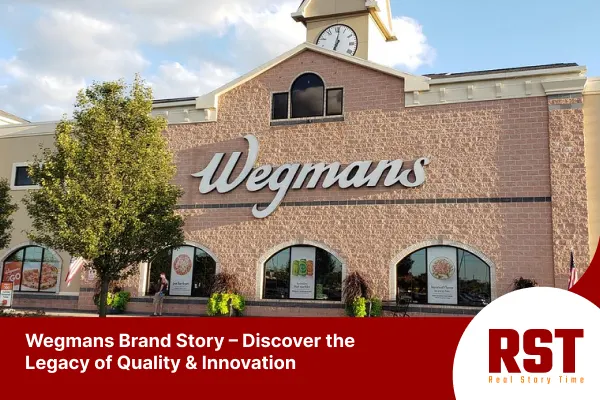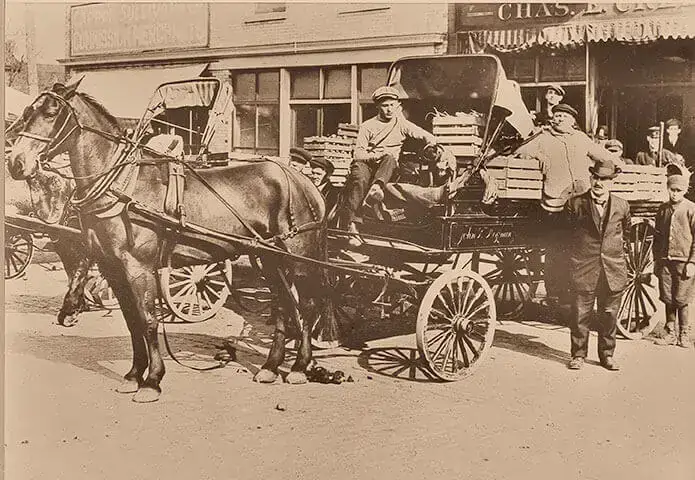Wegmans Brand Story: Discover the Legacy of Quality & Innovation
By Kushal Shrestha - Mar 18, 2025 | Updated: March 18, 2025 | 21 min read

Do you wonder about Wegmans brand evolution and its journey from a humble produce cart to a nationally recognized grocery icon? Imagine a grocery store where shopping is a fun adventure and every trip looks like a party of the simple moments of life. It is not just a store out there; Wegmans is a family operation that has been running for more than 100 years worldwide, making it committed to nourishing the body and spirit.
Wegmans, created by the two brothers John and Walter Wegman in 1916 with a load of fresh vegetables and fruits in a pushcart, resulted from their innovative thinking that food should be affordable and pleasant. Like most startup’s journey, Wegmans also started with a vision. The foremost objective has always been to offer the best quality items and give people the best time while shopping, thus uniting them.
Wegmans, the famous brand, started as a small produce cart and later on became a national grocery giant, but all the time, it has successfully kept the family-owned spirit of heart it was built on alive; this is an indication of nature’s consistency in sticking to our time-honored beliefs and values.
What makes Wegmans different is the unreserved commitment to novelty and originality that shapes its very essence. A company run by a family for four generations has always been able to enforce the set principles of its business and simultaneously adapt to the environment to become a loved nationwide company without losing touch with the local population, which has been so dear to us.
Their role is not only distributing food; it’s about making the moments in our lives blissful. This collaboration of the old with the new is a crucial contributor to the Wegmans changes and developments that result in the fact that they are the same but different, and in that way, they are always flawless and relevant.
Every brand has its own story, including Wegmans. Let’s explore!
The Origin Story: Wegmans Brand Evolution
Inspiration Behind the Brand

Founders and Their Initial Struggles
Not every company has a problem that has no hurdles. There were many challenges to achieving business success as that pioneering grocery chain faced its share of trials and tribulations.
Due to limited funds, John Wegman created the Rochester Fruit & Vegetable Company in 1916. To begin with, they started a simple pushcart, and the two brothers had to work very hard for the resources needed to keep this business afloat. The biggest obstacle was the risk of running out of funds, particularly with the 1930 opening of a larger store. Undoubtedly, the investment would be substantial, so the brothers had to engage in some business project planning to do this. This period was the most significant time of all in Wegmans brand evolution, and it was the period when the two brothers wrapped their emotions around developing new, refreshing ideas and the practical needs of the business.

Formerly, Wegmans had to contend with regulars and street food vendors to go to established grocery stores. They had to offer the best quality products, helping them compete with almost every other grocery store, but also do it differently, providing unique and innovative services.
The brothers had to put in a lot of hard work to gain the trust and customer base of the local community. In those first few years, Wegmans’ customer service and product quality approach were the pillars it stood upon for the later decades of its brand evolution.
The installation of a 20,000-square-foot store that was equipped with a cafeteria and refrigerated displays in the future became a highlighted move by the company. Nonetheless, the system was not free of its own set of problems. The two were confronted with a number of these new technologies that were involved in their operations. Hence, there is a need to be both efficient and effective.
Apart from the learning process, the capability of managing a more vast and complex operation was also essential. These changes were a revolutionary step in the evolution of the Wegmans brand, making the company among the best in the grocery retail space.
Throughout the 1980s, Wegmans dealt with another significant problem: a disturbing number of dropouts from the local schools made it hard to find good, stable employees. To solve the problem, the company designed a work-scholarship scheme that incentivized students in danger of dropping out to do their due diligence in school and have a chance to work at Wegmans for the rest of their lives.
Because of this effort, the company got benefits and made a significant difference in the local community, improving the Wegmans brand evolution by linking business achievement to social responsibility.
At first, John and Walter Wegman faced some vast problems, but they didn’t let those get in their way because they used their will and creativity to solve them. Wegmans’ unwavering support for quality, outstanding consumer service, and continuous improvement have become the company’s essential keys to its undeniable success. One thing is clear: obstacles, in the beginning, are indeed an essential signal that the most substantial companies are the ones that are determined and not afraid to take bold steps.
The Pushcart Promise: How Wegmans Began
Glancing at the sky, John Wegman was visible as he stood on the intersection of Joseph Avenue, Rochester, New York, with a load of fresh apples, oranges, and vegetables to make a profit from the people who were there. The 24-year-old college graduate, who was looking for a way to start his own business, has just started his first grocery store after learning all about how it works from his parents’ little shop. His parents used to own a small grocery store, and John was educated in quality and customer service since he was a child.
As John was selling produce to factory workers and homemakers, his younger brother Walter approached him with an idea. “How would we scale the business?” asked Walter. “We might acquire a bigger location, like a shop.” I’m thinking of quitting my job at the bank and coming over to assist you in business,” he spoke with an excited look in his eyes.
John thought about the hazard. They had some savings from their joint account, and the request for fresh produce products increased in parallel to the growth of the town’s population. The brothers rented a small area and modified their cart business into the Rochester Fruit and Vegetable Company by pooling their money.
Their initial concrete location on Monroe Avenue came to the surface in 1941. John made a conscious effort to purchase the freshest fruits and vegetables from local farmers. At the same time, Walter simultaneously took care of the accounts and came up with groundbreaking marketing strategies. They were the first to introduce the so-called loyalty program to their customers, a trading-stamp collection system that could later accumulate to get discounts on products.
While other businesses went out of business due to the Great Depression, the Wegman brothers went through a golden period by offering products people could afford. Thus, they did not lose their customers. They started selling their chickens in the shop and had the bread they baked, which, along with the soothing air, influenced people to go to their shop even in those tough times.
In 1930, it all changed when they launched a groundbreaking store that was 20,000 square feet and was a place where innovations that would change grocery shopping forever were introduced. They were among the few, and the first to have refrigerated display cases installed themselves. They also sprayed water vapor over the produce to keep the fruit and vegetables firm, including a 300-seat cafeteria where customers could sample the food before buying.
Over the years, the Wegman brothers made sure their priority was to make the very best and freshest food while, at the same time, being able to struggle through it personally and pay for United shopping. They were sure the wagon they hitched to the star of their unique delivery idea (Wegman’s pushcart) had become a passage to a provincial (of their local surroundings) institution, making it clear that simple cart commerce is the most inspired business concept.
This brave start showed Wegmans brand evolution: from a small pushcart operation to one of America’s most loved grocery chains.
Wegmans Private Label Story: Building a Grocery Empire From Within
Wegmans joined the private label market in 1979 to create labeled products that all stores could purchase through their buying program. This choice of strategy made it possible for Wegmans to have premium quality commodities at friendly prices, making it easier for customers to become brand loyal to the company. Developing its brand identity signified an essential growth moment during Wegmans brand evolution because the company moved beyond concentrating on selling national brands.
“Operation Eat Right” was launched in 1991 by Colleen Wegman to emphasize food products’ quality, taste, and emotional aspects. The “Food You Feel Good About” brand series became operational in 2005 when it first appeared as a 32-product catalog yet expanded into more than 900 natural ingredient-based products without artificial additives. The move marks another milestone in Wegmans brand evolution as the company has established itself as a leader in promoting transparent, healthy food choices.
Wegmans was the initial business to create a private label divided into quality levels and national brands. It also integrated the strategy and supply chain vertically, including 12 distribution locations, ensuring high quality, equality, and fast inventory control. These factors contributed to its stringency and swiftness in inventory turnover.
Wegmans has honed its private-label product by expanding the line from conventional to organic, gluten-free, and other items. In addition to the private label initiative, the company’s green and sustainable eco-friendly packaging and sourcing practices have been set as standard procedural goals.
The road was not smooth. In January 2025, Wegmans announced it would remove its FYFGA (For Your Family, Great Always) Chicken Breast Nuggets from the market because they contained possible bone fragments. Wegmans always takes food safety seriously, and the company has demonstrated its commitment to safety and reliability through transparent recall procedures.
Wegmans’ private label products comprise a substantial section of its business, covering fresh food categories, groceries, and health product lines. Wegmans maintains a perfect reputation as a private label powerhouse because its exclusive brands exceed national brand quality standards yet remain competitively priced.
READ MORE: Tesla’s brand story: How Elon Musk’s Iconic Company Got Its Name?
Wegmans Brand Evolution Logo: A Century of Growth
Wegmans has experienced an extreme logo redesign since its founding as a green grocery store to evolve into a widespread supermarket network throughout the last century. The Wegmans brand evolution tells a story of how the company has changed its visual identity to harmonize with the growth and expansion of the supermarket industry.
Early Years (1916-1970)
- Founded in 1916, the Rochester Fruit and Vegetable Company was founded by John Wegman.
- There was no official logo during this era.
- The visual identity was unpretentious, and the store’s name was simply in a clean font.
- The main target was the transparent transmission of information, so brand differentiation was not as important.
- It was a small, family-owned business catering to the immediate community it was part of.
- This remained the same line of business throughout the 1930s and 40s.
- The formal identity logo shifted with the birth of its first official logo in 1971.
1971-2008: Bold Block Lettering

The first logo of the family business contained text-only information showing the store name. The letters appeared in lowercase form except for the first one. The glyphs in the design displayed a diagonal protrusion at their top left corner, with the right “s” being the exception. Traditional, smooth, bold printing characterized the rest of the letters in the design. There was no distinct background. The mid to late 1990s in the Wegmans brand evolution marked the company’s growth from a local market to a more established regional chain.
2008-Present: The Elegant Script

Wegmans introduced its current logo design in 2008, which remains consistent today. The updated logo presents italicized letters with semi-coherent writing using a calligraphic style. The new letters show rounded edges throughout most parts until the initial “W,” “g,” and “s” letters preserve their angles. An unornamented white canvas appears instead of traditional backgrounds. Because of this logo update, the megamarket entrances display letters instead of significant informational signs. The design’s lower part adjusts its color depending on the wall foundation.
The brand is exclusively identified by its minimalist perspective. The hypermarket chain has no other symbol than the one cited. No additional aspects have been presented. This principle was first implemented when the stores opened and has been followed ever since. Only the font design has been changed. Wegmans brand evolution showcases a remarkable growth journey, transcending traditional grocery operations to embrace complementary sectors. Wegmans drives exciting shopping by extending its offerings to prepared meals alongside unique items and improved shopping facilities, which showcase its dedication to quality advances.
Wegmans 100 Anniversary Logo

Wegmans developed a golden anniversary logo to mark its centennial celebration in 2015. In this design, the company proudly recognizes its one-hundred-year history and uses the original brand’s core elements in all its products. The above creative adaptations made Wegmans’ way of celebrating its achievements very successful while simultaneously demonstrating its loyalty to its essential brand identity, which remains unchanged.
Design Philosophy
Regardless of how it has changed, Wegmans has kept the minimalist visual approach as its stage identity. The design style has always used the company name as a focal point instead of including graphic elements. This simplification of the process guarantees the identity across various expressions, from store planking to product wrappings. Wegmans brand evolution has been steadfastly innovative and, at the same time, deeply rooted in the company’s tradition. This process ensured the company’s survival and proved it was befitting of its heritage.
The Wegmans logo demonstrates the company’s adaptability to a changing environment while being committed to central values such as quality, community, and the customer. Each version of the logo reflects the company’s growing and changing market position while still being strongly connected to its origins.
Wegmans has completely shaken up the fast grocery market; most customers and industry insiders have been charmed by the company’s exceptional performance, and many rewards await the company. The company’s innovative and strategic approach to marketing has put it in a different league, making it an intense shopping experience at Wegmans!
Brand Values and Mission
Wegmans: Where Principles Drive Success
Walter and John Wegman began their pushcart fresh produce business in Rochester, New York, in 1916. The Wegmans brothers expanded their pushcart production business to national visibility by always treating customers well and establishing exclusive and remarkable store experiences. The Wegmans brand evolution shows how companies thrive by holding onto core values that keep their unique essence intact.
Caring: The Foundation
Throughout its existence, Wegmans has built its business approach by showing sincere dedication to its employees and consumers. The Great Depression did not destabilize either their pay structure or their support for employees at Wegmans. Concern for employee loyalty became the initial cornerstone that developed the Wegmans brand evolution. Wegmans developed the basic principles into a complete package of benefits with job promotion opportunities, allowing cashiers to greet their customers personally.
High Standards: The Pursuit of Excellence
Standards at Wegmans have consistently remained at their highest level. The company pursued fresh product procurement and operated flawless store conditions when these practices lacked industry normality. The “Food You Feel Good About” initiative in 1991 removed artificial ingredients from its branded products; clean-label trends became popular earlier than that. The Wegmans brand evolution lies in the domain of quality, which makes it stand out.
Respect: The Basis for All Relationships
One of the core values Wegmans has always lived by is respect. You should know that the employees at Wegman’s always ask the staff for their opinions, and they have been able to set the atmosphere with the belief that all are equal. Presently, the main principles are the choice of diversity, trade fair practices, and the visibility of the country of origin produced through open communication to make sound business. The honor guide is the first essential step in the Wegmans brand evolution, which has been the same over the years.
Making a Difference: Community Commitment
Since its establishment, Wegmans has been committed to being a responsible community supporter in its various business missions. During the Second World War, the company could integrate various farming processes, which became very useful to the people when there was little food to ration. Currently, Wegmans hosts cooking classes and provides other necessary resources, such as food and nutrition teachings. In 2008, Wegmans introduced a smoking cessation program and abandoned the sale of tobacco products to improve health through wellness.
Empowerment: Knowledge and Authority
Wegmans precisely engaged in the proper practice of bestowing employees the power to make crucial decisions at the store. When customer service staff is empowered to make decisions, they can quickly correct the issue, leading to swift resolution. After a long training process, the employees can now make judgment calls about all kinds of issues, such as gluten-free or wine and food pairings. The brand has continuously recognized Wegmans as a company that empowers employees and has a customer-satisfaction culture.
The Evolution Continues
Over the years, Wegmans has gone from a small family store to a nationally recognized retailer with more than 110 stores. Even now, these values are an ever-present source of innovation and development that helps Wegmans remain a valuable partner in people’s quality of life. Persistent brand updates at Wegmans prove that achieving success and customer loyalty is possible by following certain principles of success and sustainability.
Wegmans’ Mission Statement
Wegmans’ aim is: “Our mission is to help people live healthier, better lives through exceptional food.”
Wegmans Brand Evolution Historical Milestones
The company began as a family-operated enterprise before becoming an American grocery chain that achieved nationwide recognition. More than a century ago, the company started and has since dedicated itself to achieving premium standards with breakthroughs and social involvement. The Wegmans brand evolved from its operational roots in a family business to become the leading food retailing chain with national expansion by following the timeline itinerary.
Early Beginnings
- Walter E. Wegman helped out in his family’s grocery operation, while his sibling John conducted business selling fresh produce through a pushcart in 1915.
- Rochester Fruit & Vegetable Company was established by John Wegman in 1916 when he created it in Rochester that year. Walter joined his brother John to manage the Rochester Fruit & Vegetable Company precisely one year after its founding by John.
Growth and Expansion
- In 1930, Wegmans opened a 20,000-square-foot Clinton Avenue store with cafeteria seating for 300.
- In 1932, Wegmans started using refrigerated display windows and vaporized water sprays to produce fresh products.
- Robert Wegman officially joined the company in 1937 before becoming its president in 1950.
- Wegmans opened its semi-automated Central Bakeshop on Brooks Avenue in 1959.
- In 1964, Danny Wegman joined the company.
Innovation and Technology
- Wegmans established itself as one of the first barcode scanning system users in New York State in 1974.
- In 1991, Wegmans launched the “Food You’ll Feel Good About” effort, eliminating artificial ingredients from private-label products.
- In 2010, Wegmans debuted its mobile app.
Community and Sustainability
- In the 1970s, Wegmans started sending food donations of wholesome items that could not be sold to local food pantries.
- In 1984, Wegmans created the Employee Scholarship Program, offering over $135 million in tuition assistance to employees, an amount that surpasses these amounts yearly.
- The Hillside Work-Scholarship Connection emerged in 1987 as a new initiative of Wegmans to help urban youth.
- Wegmans eliminated tobacco items from all locations while dedicating resources to smoking cessation initiatives in 2008.
- Throughout the COVID-19 outbreak in 2020, Wegmans provided $4 million in support to all 47 food bank partners.
Recognition and Awards
- The company shares its core values, which Danny Wegman articulated under “Who We Are” in 2001.
- Danny Wegman took charge of the Wegmans CEO position when the company promoted him in 2005.
- Danny Wegman earned the Hall of Achievement award from the Grocery Manufacturers Association when the association recognized him with this honor in 2013.
- Wegmans celebrated its 100th year in business in 2016, and consumers, through national consumer research, selected it as their favorite supermarket.
- Colleen Wegman will become president and CEO in 2017, and Danny Wegman will become chairman.
- Nicole Wegman took the leadership position as President of the Wegmans Brand in 2021.
Recent Developments
- Wegmans began expanding across Connecticut, Delaware, and Lake Grove, New York, in 2022, building new markets in these regions.
Conclusion: Wegmans’ Enduring Legacy
Wegmans has come a long way from being a tiny produce cart to becoming widely recognized as the dominant grocery store. The company, which was launched in 1916 as the Rochester Fruit & Vegetable Company, has undergone a drastic transformation over the years through the Wegmans brand evolution and has become an institution that is loved and respected by many people and is setting the standard for grocery retail.
Wegmans has been the brand of timeless creativity wrapped in innovation for its entire existence. Family-owned values have guided four leaders over four generations, remaining at the core of every decision, from selling pet products only in local stores to setting up new stores.
Sustainability is a key element guiding Wegmans brand evolution. Wegmans delivers successful business outcomes while promoting environmental responsibility by eliminating plastic bags, selecting local suppliers, and implementing sustainable practices.
The Wegmans brand story presents an account of building relationships between family members, team members, and buyers while conducting service for regional societies. Since its founding, the Wegmans brand has evolved and maintained a central focus on human relationships.
Wegmans’s combination of quality, leadership, innovation, and community care positions the company to maintain its current industry leadership in the future. The upcoming stage of Wegmans brand evolution shows excellent potential to match the remarkable achievements of past developments.
Notice an error?
Help us improve by submitting a correction.







